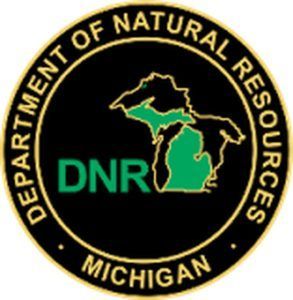Wild Goose Chase: MUCC’s Habitat Program Coordinator Bands Geese with Michigan DNR
A typical Monday for MUCC’s Habitat Program Coordinator consists of completing paperwork from the previous weekend’s event and responding to emails. This Monday looked a little different. Instead of catching up on emails, I went on a wild goose chase to catch Canada geese around the Lansing area. As an early career biologist, I am always seeking opportunities to get my hands dirty in the field and gain new experience. What’s a better way to get dirty than to catch geese straight out of wastewater treatment ponds? While this task might not sound glamorous or fun to most people, it is important and necessary.
Why band geese?

Habitat Program Coordinator, Sarah, ready to hand off the young goose for banding.
State and federal agencies work together to band geese throughout Michigan. As a Habitat Program Coordinator, it is important to network and form strong relationships with a variety of wildlife management agencies in Michigan. On Monday, I joined the Michigan Department of Natural Resources (MDNR) and the United States Department of Agriculture Wildlife Services (USDA-APHIS) to band geese. Banding allows researchers to gain insight on populations in certain areas of the state and take samples to test birds for avian influenza. Bands provide valuable information including breeding and wintering distribution, reproduction, behavior, survival, and migratory routes. This data helps biologists manage these complex and mobile species. Reporting bands on a harvested bird helps waterfowl managers determine the length of hunting seasons and bag limits to match the current size of populations. To learn more about waterfowl management in Michigan, click HERE.
How do biologists catch geese?
You might be asking yourself, how do biologists catch a gaggle (flock) of geese? Summer is an ideal time to band geese because they go through a molting period during this time. This means they are not able to fly until their flight feathers come back in and their young have not yet learned how to fly. The first step is to determine the location of the flock and the direction they need to go to avoid getting back in water. Popular areas that geese enjoy to spend their time include parks, wastewater treatment ponds, and golf courses. Then, agency staff work together to herd the geese into a temporary pen. Kayaks are used to herd geese in the water and a line of people for when they are on land. A couple people get inside the pen with the geese, while the others form an assembly line.

Geese in a temporary pen waiting to be banded.
Those in the pen secure a goose, hand it to the person in the front of the line, and the goose is handed to one of the banders. Banders pull back the goose’s feathers to determine its sex and age. A small, silver U.S. Fish and Wildlife Service leg band with a serial number is added to the goose’s left leg. The sex, age, and serial number are recorded by the banders. Depending on the location, the goose will then be placed back in the “banded” side of the pen or immediately released. This process continues until all geese in the pen have been banded. Geese are unharmed throughout this process and they are banded under a research permit. It is important to not touch wildlife unless you have the proper permits.
What to do if a banded goose is harvested?

A silver U.S. Fish & Wildlife leg band with serial number and reporting information.
If a hunter harvests a banded goose, they can report the band’s information to receive a certificate that includes the bird’s sex, age, species, and when and where it was banded. There is a website address and identification number included on the band that hunters can use if the goose is harvested. Hunters can also call a number on the band to report the bird. According to the MDNR , biologists can determine valuable information about movement patterns, harvest, and survival rates when hunters harvest a banded bird and report it. To learn more about reporting bands, click HERE.
The post Wild Goose Chase: MUCC’s Habitat Program Coordinator Bands Geese with Michigan DNR appeared first on Michigan United Conservation Clubs.
Recent Posts



